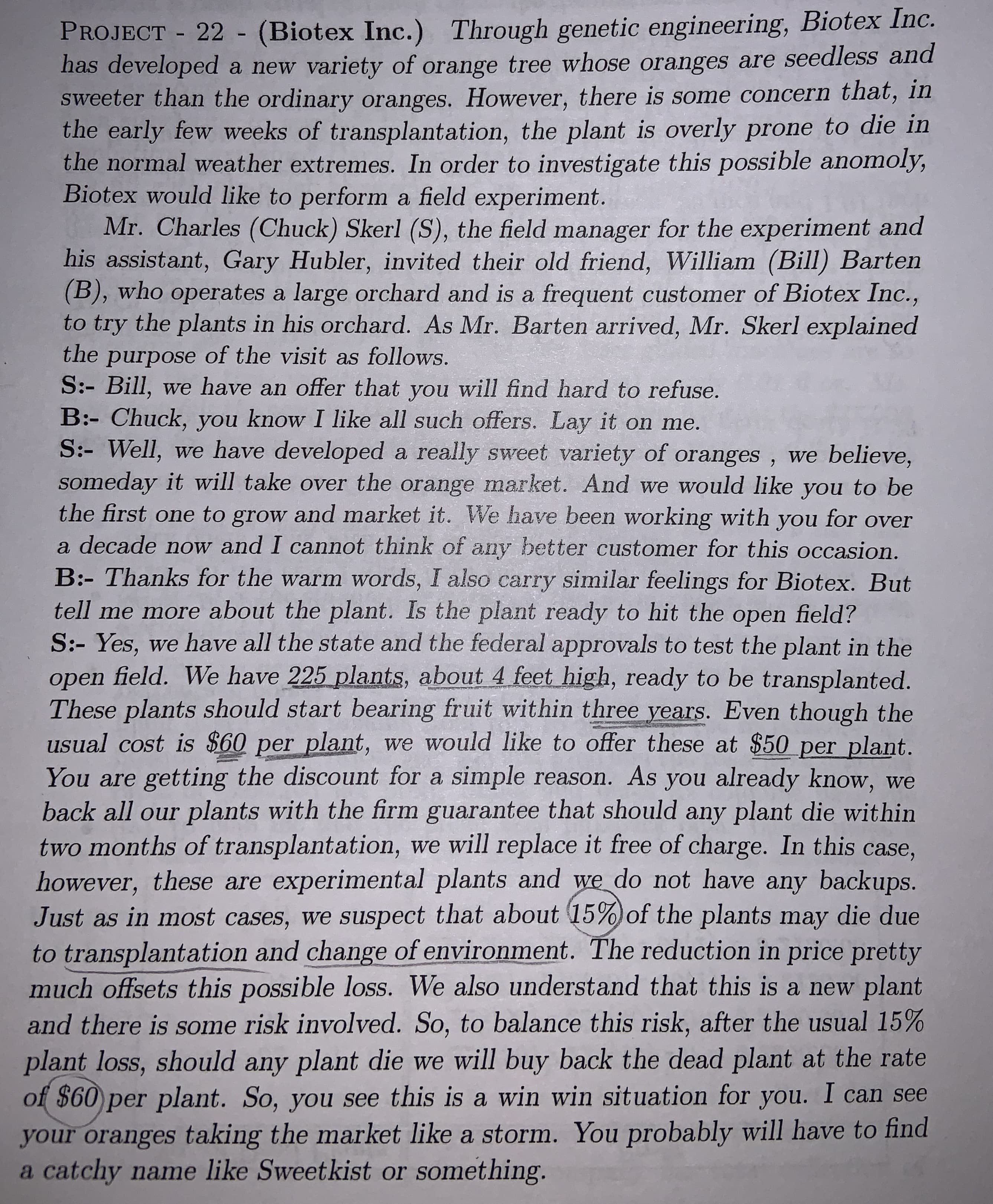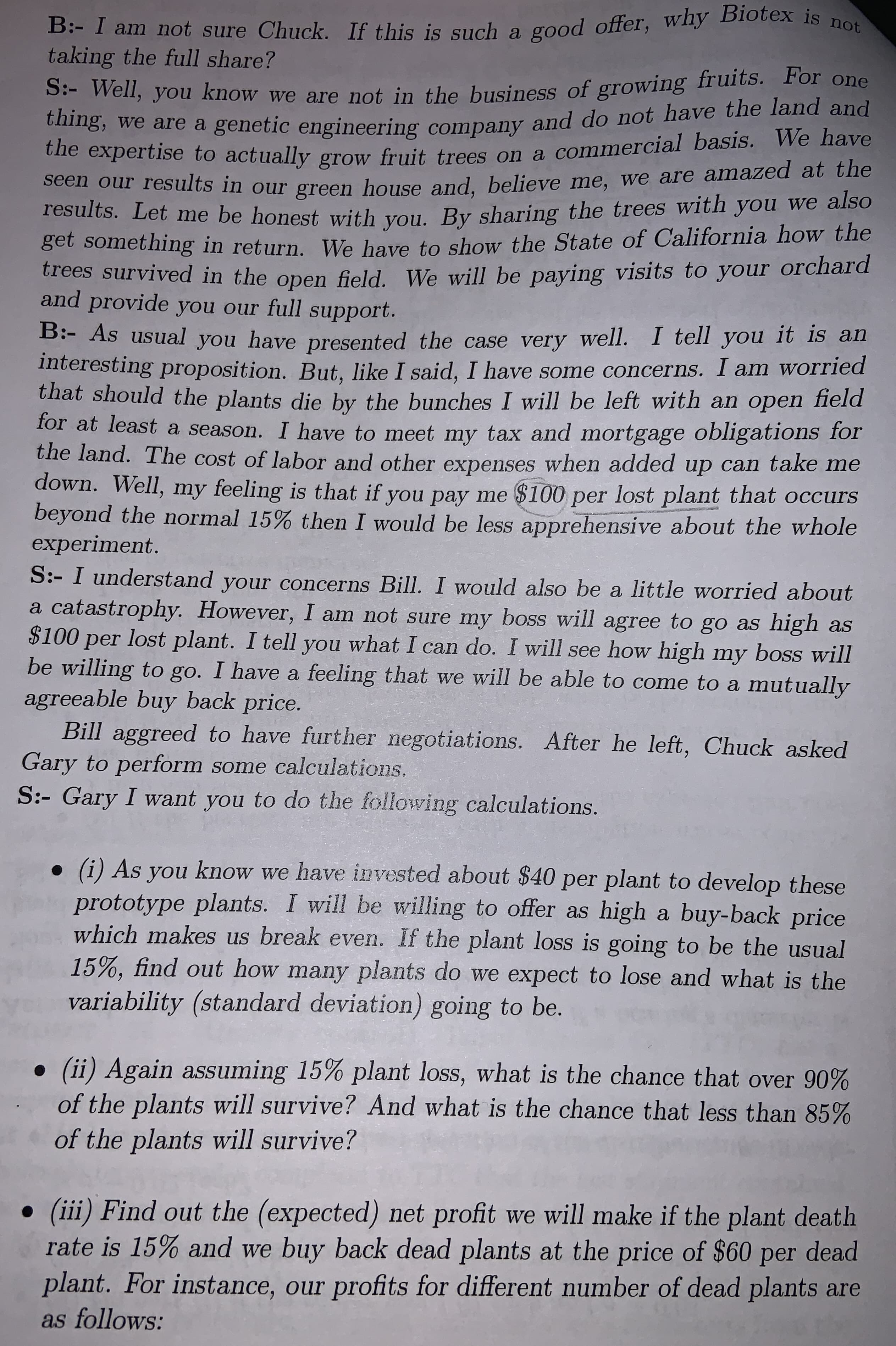PROJECT 22 - (Biotex Inc.) Through genetic engineering, Biotex Inc. has developed a new variety of orange tree whose oranges are seedless and sweeter than the ordinary oranges. However, there is some concern that, in the early few weeks of transplantation, the plant is overly prone to die in the normal weather extremes. In order to investigate this possible anomoly, Biotex would like to perform a field experiment. Mr. Charles (Chuck) Skerl (S), the field manager for the experiment and his assistant, Gary Hubler, invited their old friend, William (Bill) Barten (B), who operates a large orchard and is a frequent customer of Biotex Inc., to try the plants in his orchard. As Mr. Barten arrived, Mr. Skerl explained the purpose of the visit as follows. S:- Bill, we have an offer that you will find hard to refuse. B:- Chuck, you know I like all such offers. Lay it on me. S:- Well, we have developed a really sweet variety of oranges , we believe, someday it will take over the orange market. And we would like you to be the first one to grow and market it. We have been working with a decade now and I cannot think of any better customer for this occasion. B:- Thanks for the warm words, I also carry similar feelings for Biotex. But tell me more about the plant. Is the plant ready to hit the open field? S:- Yes, we have all the state and the federal approvals to test the plant in the open field. We have 225 plants, about 4 feet high, ready to be transplanted. These plants should start bearing fruit within three years. Even though the usual cost is $60 per plant, we would like to offer these at $50 per plant. You are getting the discount for a simple reason. As you already know, we back all our plants with the firm guarantee that should any plant die within two months of transplantation, we will replace it free of charge. In this case, however, these are experimental plants and we do not have any backups. Just as in most cases, we suspect that about 15%) of the plants may die due to transplantation and change of environment. The reduction in price pretty much offsets this possible loss. We also understand that this is a new plant and there is some risk involved. So, to balance this risk, after the usual 15% plant loss, should any plant die we will buy back the dead plant at the rate of $60 per plant. So, you see this is a win win situation for you. I can see your oranges taking the market like a storm. You probably will have to find a catchy name like Sweetkist or something. for over you B:- I am not sure Chuck. If this is such a good offer, why Biotex is not taking the full share? S:- Well, you know we are not in the business of growing fruits. For one thing, we are a genetic engineering company and do not have the land and the expertise to actually grow fruit trees on a commercial basis. We have seen our res ults in our green house and, believe me, we are amazed at the results. Let me be honest with you. By sharing the trees with you we also get something in return. We have to show the State of California how the trees survived in the open field. We will be paying visits to your orchard and provide you our full support. B:- As usual you have presented the case very well. I tell you it is an interesting proposition. But, like I said, I have some concerns. I am worried that should the plants die by the bunches I will be left with for at least a season. I have to meet my tax and mortgage obligations for the land. The cost of labor and other expenses when added up can take me down. Well, my feeling is that if you pay me $100 per lost plant that occurs beyond the normal 15% then I would be less apprehensive about the whole experiment. an open field S:- I understand your concerns Bill. I would also be a little worried about a catastrophy. However, I am not sure my boss will agree to go as high as $100 per lost plant. I tell you what I can do. I will see how high my boss will be willing to go. I have a feeling that we will be able to come to a mutually agreeable buy back price. Bill aggreed to have further negotiations. After he left, Chuck asked Gary to perform some calculations. S:- Gary I want you to do the following calculations. . (i) As you know we have invested about $40 per plant to develop these prototype plants. I will be willing to offer as high a buy-back price which makes us break even. If the plant loss is going to be the usual 15%, find out how many plants do we expect to lose and what is the variability (standard deviation) going to be. (ii) Again assuming 15% plant loss, what is the chance that over 90% of the plants will survive? And what is the chance that less than 85% of the plants will survive? (iii) Find out the (expected) net profit we will make if the plant death rate is 15% and we buy back dead plants at the price of $60 per dead plant. For instance, our profits for different number of dead plants are as follows:
Inverse Normal Distribution
The method used for finding the corresponding z-critical value in a normal distribution using the known probability is said to be an inverse normal distribution. The inverse normal distribution is a continuous probability distribution with a family of two parameters.
Mean, Median, Mode
It is a descriptive summary of a data set. It can be defined by using some of the measures. The central tendencies do not provide information regarding individual data from the dataset. However, they give a summary of the data set. The central tendency or measure of central tendency is a central or typical value for a probability distribution.
Z-Scores
A z-score is a unit of measurement used in statistics to describe the position of a raw score in terms of its distance from the mean, measured with reference to standard deviation from the mean. Z-scores are useful in statistics because they allow comparison between two scores that belong to different normal distributions.
please solve the bullet points question.
please show me details for the answers and what are the formulas used
for question 2 please once done solving draw the bell shaped graph with labels such as ( 90%) or (80%).


Trending now
This is a popular solution!
Step by step
Solved in 2 steps with 1 images









